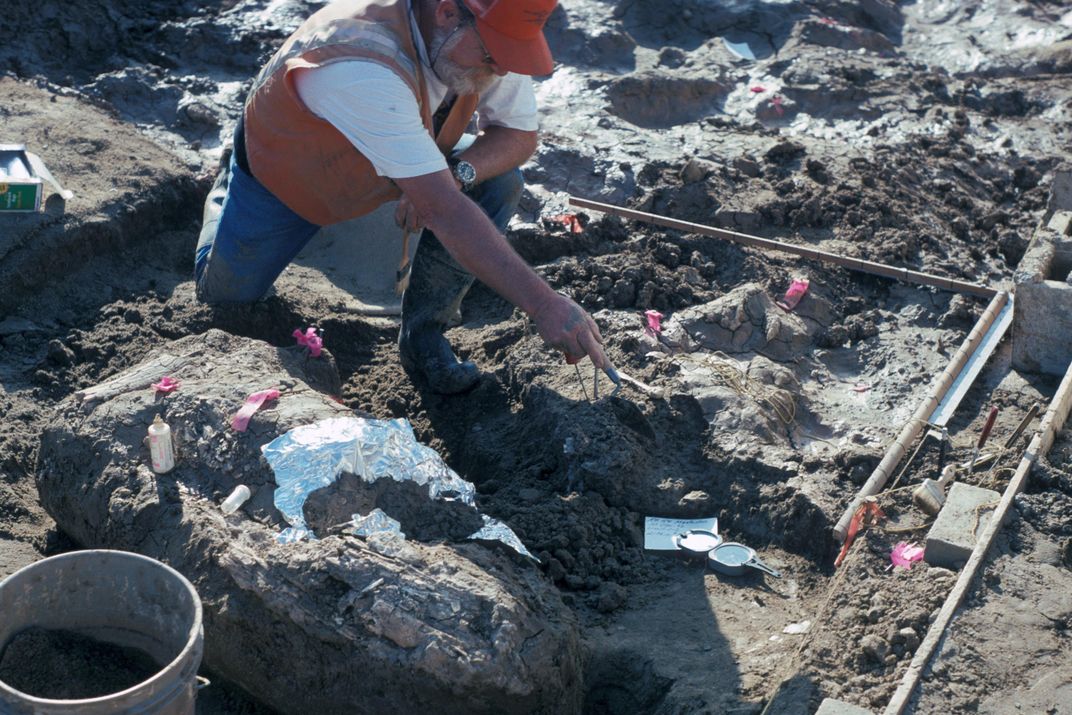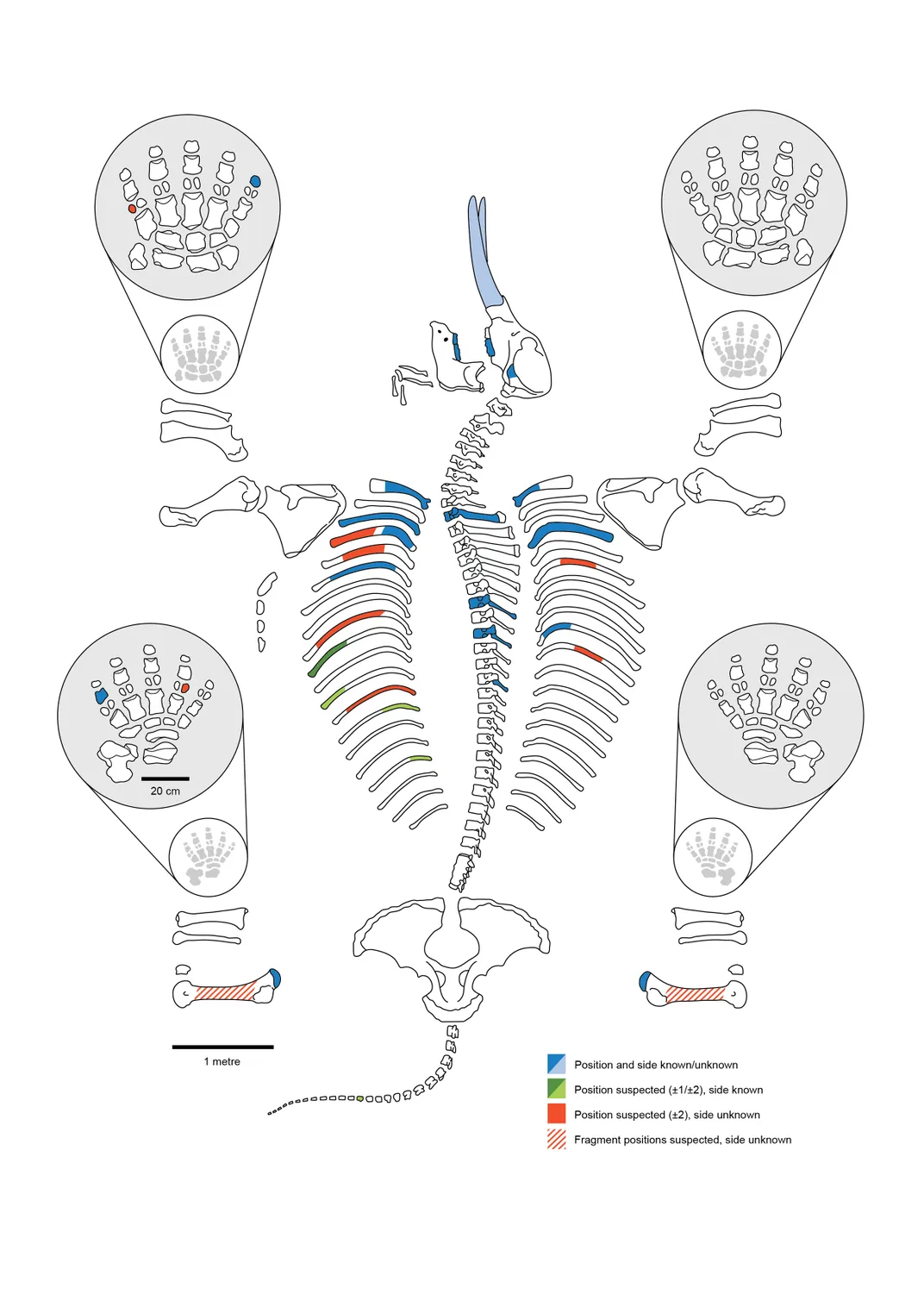Remarkable New Evidence for Human Activity in North America 130,000 Years Ago
Researchers say prehistoric mastodon bones bear human-made markings
:focal(1658x1898:1659x1899)/https://tf-cmsv2-smithsonianmag-media.s3.amazonaws.com/filer/43/c0/43c06674-d5c9-4e94-8b48-e3fee6344e71/cms-specimen-2.jpg)
In 1992, construction workers were digging up a freeway in San Diego, California when they came across a trove of ancient bones. Among them were the remains of dire wolves, camels, horses and gophers—but the most intriguing were those belonging to an adult male mastodon. After years of testing, an interdisciplinary team of researchers announced this week that these mastodon bones date back to 130,000 years ago.
The researchers then went on to make an even more stunning assertion: These bones, they claim, also bear the marks of human activity.
The team’s findings, published today in the journal Nature, could upend our current understanding of when humans arrived in North America—already a flashpoint among archaeologists. Recent theories posit that people first migrated to the continent about 15,000 years ago along a coastal route, as Jason Daley writes in Smithsonian. But in January, a new analysis of horse remains from the Bluefish Caves by archaeologist Jacques Cinq-Mars suggested that humans may have lived on the continent as early as 24,000 years ago.
The new study, however, suggests that some type of hominin species—early human relatives from the genus Homo—was bashing up mastodon bones in North America about 115,000 years earlier than the commonly accepted date. That’s a staggeringly early date, and one that is likely to raise eyebrows. There is no other archaeological evidence attesting to such an early human presence in North America.
“I realize that 130,000 years is a really old date,” Thomas Deméré, principal paleontologist at the San Diego Museum of Natural History and one of the authors of the study, conceded during a press conference. “Of course, extraordinary claims like this require extraordinary evidence.” Deméré and his co-authors believe that their discoveries at the Cerutti Mastodon site—as the area of excavation is known—provide just that.

Palaeontologists working at the site found an assortment of mastodon remains, including two tusks, three molars, 16 ribs, and more than 300 bone fragments. These fragments bore impact marks suggesting that they had been smacked with a hard object: Some of the shattered bones contained spiral fractures, indicating that they were broken while still “fresh,” the authors write.
Amidst the fine-grain sands at the site, researchers also discovered five hulking stones. According to the study, the stones were used as makeshift hammers and anvils, or “cobbles.” They showed signs of impact—fragments found in the area could in fact be repositioned back into the cobbles—and two distinct clusters of broken bones surrounded the stones, suggesting that the bones had been smashed in that location.
“These patterns taken together have led us to the conclusion that humans were processing mastodon bones using hammer stones and anvils,” Deméré said at the press conference. He was joined by three of his co-authors: Steven Holen, co-director of the Center for American Paleolithic Research; James Paces, a research geologist at the United States Geological Survey; and Richard Fullagar, a professor of archaeology at the University of Wollongong, Australia.
There is no evidence of butchery at the site, so the team suspects that its occupants were breaking the bones to make tools and extract marrow.
To bolster their theory, researchers analyzed mastodon bones found in later North American sites, which date from 14,000 to 33,000 years ago. These bones displayed the same fracture patterns that were observed among the remains of the Cerutti Mastodon. Researchers also tried to replicate the activity that may have occurred at the site by smacking at the bones of a recently deceased elephant, the mastodon’s closest living relative.
Their efforts “produced exactly the same kinds of fracture patterns that we see on the Cerutti mastodon limb bones,” said Holen.
“[W]e can eliminate all of the natural processes that break bones like this,” Holen added. “These bones were not broken by carnivore-chewing, they were not broken by other animals trampling on the bone.”

While some members of the team were wreaking havoc on elephant remains, efforts were underway to date the Cerutti mastodon bones.
Attempts at radiocarbon dating proved unsuccessful because the bones did not contain a sufficient amount of carbon-containing collagen. So researchers turned to uranium–thorium dating, a technique that is often used to check radiocarbon-derived dates. Uranium–thorium dating, which can be used on carbonate sediments, bones and teeth, makes it possible to date objects far older than 50,000 years, the upper limit of radiocarbon dating. Using this method, scientists were able to assign an approximate age of 130,000 years to the Cerutti bones.
While the study’s authors believe that their evidence is ironclad, other experts aren’t so sure. Briana Pobiner, a paleoanthropologist with the Smithsonian Institution’s Human Origins Program, says it is “nearly impossible” to rule out the possibility that the bones were broken by natural processes, like sediment impaction.
“I would have liked to see really easily identifiable stone tools,” she says “[The study theorizes that early humans were] bashing open bones with natural rocks. Both of those things are kind of hard to distinguish in the archaeological record book: natural rocks that were used and also the bones that were bashed open.”
Still, Pobiner says she is excited about the researchers’ findings. “They have broken mammoth bones, they have broken stones, they have patterning, and damage and wear on both the bones and the stones, which look human-modified,” she explains. “I think that the combination of evidence is on the way to being convincing.”
The authors of the study have anticipated that their conclusions will be met with some wariness. “I know people will be skeptical of this, because it is so surprising,” Holen said during the press conference. “I was skeptical when I first looked at the material myself. But it's definitely an archaeological site.”
Researchers also acknowledged that for now, the study raises more questions than it answers. For instance: Who were the early humans described by the study, and how did they arrive in North America? “The simple answer is we don't know,” said Fullagar.
But he went on to venture a few guesses. The occupants of the Cerutti Mastodon site could have been Neanderthals, their Denisoven cousins, or even anatomically modern humans. They might have been some type of hybrid population. “[R]ecent genetic studies indicate that rather than dealing with a single, isolated species of migrating hominids or humans, we're actually dealing with an intermixing, a kind of meta population of humans,” Fullagar noted.
These humans, whoever they were, may have migrated across the Bering land bridge or sailed along the coast to North America, researchers said. There is evidence to suggest that early humans in other parts of the world were able to make water crossings. Archaeologists have found hand axes dating to at least 130,000 years ago on the island of Crete, which has been surrounded by water for about five million years, according to Heather Pringle at National Geographic.
Moving forward, the team plans to seek out new archaeological sites and take a fresh look at artifact collections that may contain undetected signs of human activity. “[W]e fully intend to keep this type of research going in the future, to look in collections all over Southern California, and to continue to do fieldwork looking for more sites of this age,” Holen said.
If humans did roam through North America 130,000 years ago, their numbers were likely sparse. This means that the chances of finding human remains are slim—but not out of the question, says Pobiner of Smithsonian. “If people were in North America 130,000 years ago,” she said. “I don't see why we wouldn't find them.”

